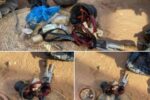Seven More Bodies Recovered In Niger State Flood Disaster As De@th Toll Rises

No fewer than seven additional bodies have been recovered following the devastating flood in Mokwa, Niger State, raising the de@th toll further.
The Niger State government announced this on Tuesday.
This was revealed in a statement issued in Minna by the Secretary to the State Government, Abubakar Usman.
According to Usman, four of the bodies were recovered on Monday, one in the early hours of Tuesday, and two more later the same day as part of ongoing search efforts.
SaharaReporters earlier reported that the de@th toll from the flooding, which devastated Mokwa, a local government area in Niger State, had reportedly reached at least 200.
It was noted that about 500 people are still missing.
Rescue efforts were also said to be dwindling, as authorities fear there may no longer be any survivors.
SaharaReporters earlier reported that victims of the Mokwa flood disaster claimed the devastating incident — which has now led to the loss of 200 lives and displaced thousands — was not caused by rainfall but by a suspected release of water from the Kainji Dam.
Residents who spoke to SaharaReporters on Friday in Mokwa, the headquarters of Mokwa Local Government Area (LGA), had said the flood, which occurred in the early hours of May 29, 2025, came without heavy rainfall the night before. This led many to believe it was not a natural flood.
Several locals also noted that in the days preceding the disaster, parts of New Bussa town in Borgu LGA of Niger State experienced partial flooding.
Some farmers in Mokwa noticed rising water levels across their farmlands but did not anticipate the scale of destruction that followed.
One of the victims, AbdulGafar, who lost everything he had worked for during the flood, insisted the water’s arrival was sudden and unnatural.
“I believe the flood is not as a result of rainfall. If it was rain it would have affected us in the middle of the night or the flood could have come at midnight. It is terrible that we are witnessing this thing in our lives.”
He further explained that although the community had faced serious erosion before, the disaster was unlike anything previously experienced.
“We’ve not had it this bad. We’ve been experiencing erosion, a serious one of that.”
“But this is the worst we’ve ever experienced. And I can categorically say that this is not rain.”
“But water, which we can actually link to the Kainji Dam, because it was a heavy flood that came.”
Another victim, Salihu Suleiman, who also lost all his properties and investments, emphasised that no heavy rainfall preceded the flood.
“This flood is not from rain water because there was not that heavy downpour a day before the devastating incident.”
“Around 6am, I and my wife woke up to pray subh prayer (morning prayer) to prayed and went back to sleep and 4 to 5 minutes later my mom came knocking at the door she was shouting come out tell your wife to come out and I rushed out she was like water is coming I should call my wife and I called her we ran we ran out that would not pick anything I came out with only my singlet and boxers alone without picking anything not even my phone.”
SaharaReporters previously reported that the flood submerged houses, washed away farmlands, and left thousands stranded across Mokwa.
The flooding also destroyed over 3,000 homes, forcing mass displacement.
The Kainji Dam, located on the Niger River near New Bussa in Niger State, is one of West Africa’s largest dams.
It is vital for hydroelectric power generation, irrigation, and water supply in the region.





